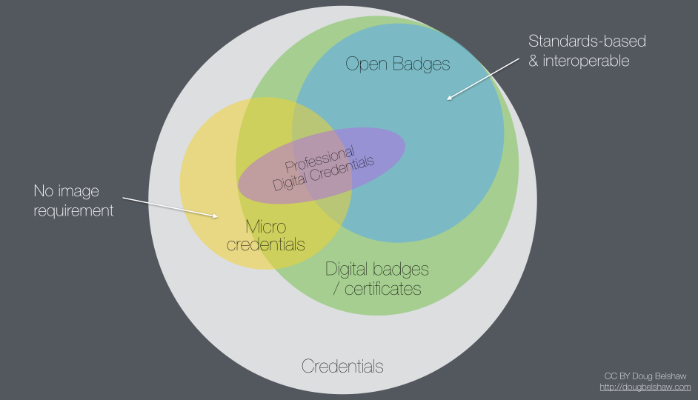What is a ‘credential’ anyway?

Carla Casilli, badge system design expert extraordinaire, former colleague, and one of the authors of the report I shared my notes on yesterday, has recently been writing about the nature of badges and credentials. In her most recent post she asks the community:
Are all badges credentials, regardless of conceptual size, depth of assessment, or amount of criteria?
Last year I wrote for DML Central entitled Taking Another Look At The Digital Credentials Landscape. In it, I created a visual representation of how I, and others I’d consulted through my work with City & Guilds, saw the current digital credentialing landscape. As you can see from the image below, we situated everything within a meta-level circle of ‘credentials’.

What I (spectacularly) failed to do in that post was to define what I meant by ‘credential’. I assumed that everyone was using the term in the same way as I (and I assume most Europeans do). The Quality Dimensions for Connected Credentials report from the American Council on Education uses the Lumina Foundation’s definition of a credential as:
A documented award by a responsible and authorized body that has determined that an individual has achieved specific learning outcomes relative to a given standard. Credential in this context is
an umbrella term that includes degrees, diplomas, licenses, certificates, badges, and professional/industry certifications.
While this is not a bad definition, it is rather limiting; I think it’s overly-focused on traditional education. The word ‘credential’ comes from the Latin ‘credentia’ via the English word ‘credence’. To give credence to something is to ascribe validity, often via a recommendation; it is a state of belief in something as being true. Credential letters in the Middle Ages were handed from a person unknown to the recipient from someone known to the recipient (if only by reputation). As a result, the recipient would be more likely to see the person in front of them as ‘credible’. It was credibility by association.
The meanings and definitions of words change over time, of course, but I think that the second half of the Lumina Foundation’s definition, the part that talks of ‘credential’ as an ‘umbrella term’ is key. I’d just reject the first half where it talks about ‘responsible and authorised’ bodies and a ‘given standard’.
This ‘umbrella term’ approach to defining ‘credentials’ also meshes with the definitions from sources that I find reasonably convincing:
- “A qualification, achievement, quality, or aspect of a person’s background, especially when used to indicate their suitability for something” (Oxford English Dictionary)
- “A credential is an attestation of qualification, competence, or authority issued to an individual by a third party with a relevant or de facto authority or assumed competence to do so.” (Wikipedia)
- “The abilities and experience that make someone suitable for a particular job or activity, or proof of someone’s abilities and experience.” (Cambridge Dictionaries)
- “Personal qualities, achievements, or experiences that make someone suitable for something.” (Macmillan Dictionary)
- “Warranting credit or confidence — used chiefly in the phrase credential letters.” (Merriam-Webster Dictionary)
I think Carla and I are arguing for the same position from two different vantage points. For example, after sharing a diagram showing two circles overlapping (but not completely) she states:
Badges, as they were envisioned originally, were created to capture learning whenever and wherever that learning occurs: formal, informal, public, private, group, individual. The overlap on the Venn diagram is sometimes referred to as microcredentials, and actually gives that term greater meaning and sense.
I definitely agree with that original vision for badges. I just can’t see a situation where a badge wouldn’t also count as a credential — even if that wasn’t the original intention .
As both the image from my DML Central post, and the image in Carla’s subsequent post demonstrates, it’s nearly impossible to do justice to the complexity of the credentials landscape in just two dimensions. Carla says:
An open badge can be designed to represent a small thing, such as a fundamental principle or a single competency (micro level) — and an open badge can also be designed to represent a large thing, like a competency set, or a license, or a degree (macro level). This visual illustrates that badges can be used to represent any credential currently being issued. This may seem like a minor thing to visualize, but given what badges can represent, it’s one that is definitely worth understanding.
I agree: if represented in three dimensions, badges would be orthoganal to the current credentialing system. They’re certainly acting at some kind of different ‘layer’. But, I would argue, if we’re forced to represent them in two dimensions, they appear to be wholly contained with the circle we currently call ‘credentials’.
What badges don’t have to be, even if they’re wholly contained within the ‘credential’ circle, is traditional. They can recognise all kinds of knowledge, skills, and behaviours — as well as all kinds of things we haven’t even thought of yet!
Image CC BY-SA Andrew Moore
I hope this was useful for those experienced in the world of Open Badges, and those who are new to the ecosystem. If you’re one of the latter, you may find the Open Badges 101 course helpful.

3 thoughts on “What is a ‘credential’ anyway?”